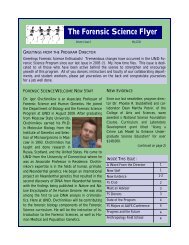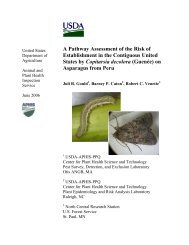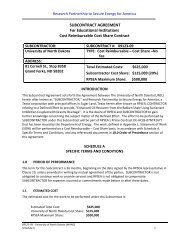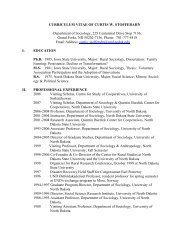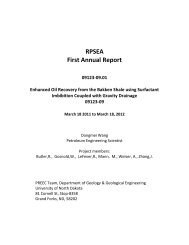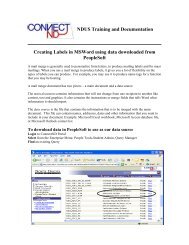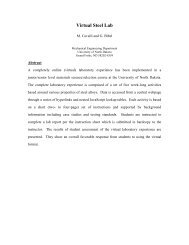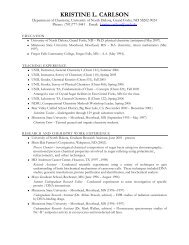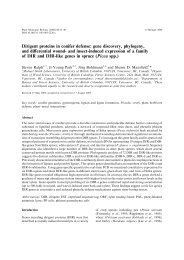Predicting Invasiveness of Plant Species Based on Biological ...
Predicting Invasiveness of Plant Species Based on Biological ...
Predicting Invasiveness of Plant Species Based on Biological ...
Create successful ePaper yourself
Turn your PDF publications into a flip-book with our unique Google optimized e-Paper software.
Goodwin et al. Invasive versus N<strong>on</strong>invasive <str<strong>on</strong>g>Plant</str<strong>on</strong>g>s 423<br />
Introducti<strong>on</strong><br />
Invasive species have become an increasingly important<br />
c<strong>on</strong>servati<strong>on</strong> issue (di Castri 1990). Invasive species enter<br />
various habitats (Baker 1986; Fox & Adams<strong>on</strong> 1986;<br />
Gray 1986; Mo<strong>on</strong>ey et al. 1986; Mack 1989) and may alter<br />
ecosystem properties and processes (Vitousek 1986;<br />
Le Maitre et al. 1996) as well as native community structure<br />
(Simberl<str<strong>on</strong>g>of</str<strong>on</strong>g>f 1981). An invasive plant may threaten<br />
the protected plant species in a reserve (Usher 1988;<br />
Macd<strong>on</strong>ald et al. 1989) or change habitat suitability for<br />
animals (Trammell & Butler 1995).<br />
Several authors have suggested that it is important to understand<br />
what biological characteristics make a species a<br />
good invader so that species that are likely to be invasive<br />
can be screened and the costs <str<strong>on</strong>g>of</str<strong>on</strong>g> invasi<strong>on</strong> can be reduced<br />
by preventing the initial introducti<strong>on</strong>s. Studies have c<strong>on</strong>sidered<br />
either a set <str<strong>on</strong>g>of</str<strong>on</strong>g> successfully invasive species (Newsome<br />
& Noble 1986; Reichard & Hamilt<strong>on</strong> 1997) or have<br />
compared species characteristics <str<strong>on</strong>g>of</str<strong>on</strong>g> native and invasive<br />
species (Baker 1965; Caldwell et al. 1981, 1983; Baruch et<br />
al. 1985; Roy 1990; Pys˘<br />
ek et al. 1995; Thomps<strong>on</strong> et al.<br />
1995). Characteristics identified as important determinants<br />
<str<strong>on</strong>g>of</str<strong>on</strong>g> invasiveness are small, short-lived seeds that can germinate<br />
without pretreatment (e.g., freezing), short juvenile<br />
periods and short intervals between large seed crops, large<br />
size, l<strong>on</strong>g flowering period, vegetative reproducti<strong>on</strong>, and<br />
perfect flowers (Crawley 1987, 1989; Perrins et al. 1992,<br />
Richards<strong>on</strong> et al. 1994; Thomps<strong>on</strong> et al. 1995, Rejmánek &<br />
Richards<strong>on</strong> 1996; Reichard & Hamilt<strong>on</strong> 1997).<br />
The usefulness <str<strong>on</strong>g>of</str<strong>on</strong>g> such characteristics for predicting<br />
which species will be invasive differs for intenti<strong>on</strong>al versus<br />
accidental introducti<strong>on</strong>s. In the case <str<strong>on</strong>g>of</str<strong>on</strong>g> plants that<br />
are intenti<strong>on</strong>ally introduced for horticultural or agricultural<br />
purposes, potential invasiveness can be assessed<br />
<strong>on</strong> a case-by-case basis when applicati<strong>on</strong> is made for importati<strong>on</strong><br />
<str<strong>on</strong>g>of</str<strong>on</strong>g> the plant. <strong>Biological</strong> attributes that predict<br />
invasiveness in such a group could be used to decide<br />
whether to grant a permit to introduce a species (e.g.,<br />
Reichard & Hamilt<strong>on</strong> 1997).<br />
If biological attributes <str<strong>on</strong>g>of</str<strong>on</strong>g> invasiveness apply to both intenti<strong>on</strong>ally<br />
and accidentally introduced species, then it<br />
should be possible to use this informati<strong>on</strong> to develop protocols<br />
for transportati<strong>on</strong> and shipping that will reduce the<br />
probability <str<strong>on</strong>g>of</str<strong>on</strong>g> accidental introducti<strong>on</strong>s <str<strong>on</strong>g>of</str<strong>on</strong>g> invasive species.<br />
A potential difficulty, however, is that many <str<strong>on</strong>g>of</str<strong>on</strong>g> the attributes<br />
used to predict invasiveness <str<strong>on</strong>g>of</str<strong>on</strong>g> intenti<strong>on</strong>ally introduced<br />
species are not available for the majority <str<strong>on</strong>g>of</str<strong>on</strong>g> species.<br />
To predict invasiveness <str<strong>on</strong>g>of</str<strong>on</strong>g> all potentially invasive species,<br />
both intenti<strong>on</strong>ally and accidentally introduced, we must<br />
limit the biological attributes to those that are available for<br />
most or all species. The first objective <str<strong>on</strong>g>of</str<strong>on</strong>g> this study therefore<br />
was to determine whether invasiveness can be predicted<br />
from comm<strong>on</strong>ly available biological informati<strong>on</strong>.<br />
In additi<strong>on</strong> to biological informati<strong>on</strong>, the geographical<br />
range <str<strong>on</strong>g>of</str<strong>on</strong>g> a species in its area <str<strong>on</strong>g>of</str<strong>on</strong>g> origin should be related to<br />
the probability <str<strong>on</strong>g>of</str<strong>on</strong>g> its moving and persisting elsewhere (invading)<br />
for two reas<strong>on</strong>s. First, wider-ranging species are<br />
more likely to come into c<strong>on</strong>tact and be carried with internati<strong>on</strong>al<br />
transport <str<strong>on</strong>g>of</str<strong>on</strong>g> goods. Sec<strong>on</strong>d, species with<br />
larger original ranges are more likely to be pre-adapted to<br />
c<strong>on</strong>diti<strong>on</strong>s in a new area (Groves 1986; Holdgate 1986;<br />
Roy 1990). Thus, our sec<strong>on</strong>d objective was to determine<br />
whether invasiveness can be predicted more successfully<br />
using biological attributes or geographic range.<br />
Methods<br />
We compared attributes <str<strong>on</strong>g>of</str<strong>on</strong>g> plant species that originated<br />
in Europe and have successfully invaded New Brunswick,<br />
Canada, to c<strong>on</strong>generic species in Europe that<br />
have not invaded North America. We included woody<br />
and herbaceous plants and species that were introduced<br />
intenti<strong>on</strong>ally and accidentally. We used c<strong>on</strong>generic pairs<br />
<str<strong>on</strong>g>of</str<strong>on</strong>g> species to minimize the potentially c<strong>on</strong>founding effects<br />
<str<strong>on</strong>g>of</str<strong>on</strong>g> phylogeny (Clutt<strong>on</strong>-Brock & Harvey 1991). We<br />
compared invasive to n<strong>on</strong>invasive species from the same<br />
source area because simple identificati<strong>on</strong> <str<strong>on</strong>g>of</str<strong>on</strong>g> attributes <str<strong>on</strong>g>of</str<strong>on</strong>g><br />
a set <str<strong>on</strong>g>of</str<strong>on</strong>g> invasive species does not imply that these attributes<br />
are important for invasiveness; they may simply<br />
be attributes <str<strong>on</strong>g>of</str<strong>on</strong>g> the source flora (Perrins et al. 1992).<br />
Using the Flora <str<strong>on</strong>g>of</str<strong>on</strong>g> New Brunswick (Hinds 1986), we<br />
identified all the flowering plants that have successfully<br />
invaded New Brunswick from Europe. To have successfully<br />
invaded, a plant had to be (1) persisting in New<br />
Brunswick, (2) from Europe or Eurasia, (3) a n<strong>on</strong>-native<br />
species in North America, and (4) associated with human-disturbed<br />
habitat. We paired each invasive species<br />
with a randomly selected, n<strong>on</strong>invasive, c<strong>on</strong>generic species<br />
in Europe according to Tutin et al. (1964). To be<br />
c<strong>on</strong>sidered for pairing, a n<strong>on</strong>invasive species had to be<br />
(1) native to Europe, (2) n<strong>on</strong>-native to North America,<br />
(3) associated with a human-disturbed habitat, and (4) in<br />
the same genus as the invasive species. We imposed the<br />
criteri<strong>on</strong> <str<strong>on</strong>g>of</str<strong>on</strong>g> being associated with human-disturbed habitats<br />
<strong>on</strong> both the invasive and n<strong>on</strong>invasive species to c<strong>on</strong>trol<br />
for the degree <str<strong>on</strong>g>of</str<strong>on</strong>g> disturbance at the invaded site,<br />
which has a large effect <strong>on</strong> the success <str<strong>on</strong>g>of</str<strong>on</strong>g> invasi<strong>on</strong> (Ewel<br />
1986; Mack 1986; Mo<strong>on</strong>ey et al. 1986; Crawley 1986,<br />
1987; Orians 1986; Hobbs 1989; Roy 1990).<br />
We found <strong>on</strong>ly three biological characters—lifeform<br />
(life), stem height (height), and flowering period (flower)—<br />
that could be gathered for a wide range <str<strong>on</strong>g>of</str<strong>on</strong>g> species from<br />
published floras. Lifeform was coded as 1, annual or biennial;<br />
2, herbaceous perennial; or 3, woody. If a range<br />
was reported for stem height or flowering period, we<br />
used the mid-point <str<strong>on</strong>g>of</str<strong>on</strong>g> the range.<br />
The Flora Europea divides Europe into 39 geographical<br />
regi<strong>on</strong>s, which we used to determine European geographic<br />
range (range) by counting the regi<strong>on</strong>s <str<strong>on</strong>g>of</str<strong>on</strong>g> Europe<br />
for which presence <str<strong>on</strong>g>of</str<strong>on</strong>g> the species was reported. For all<br />
C<strong>on</strong>servati<strong>on</strong> Biology<br />
Volume 13, No. 2, April 1999






